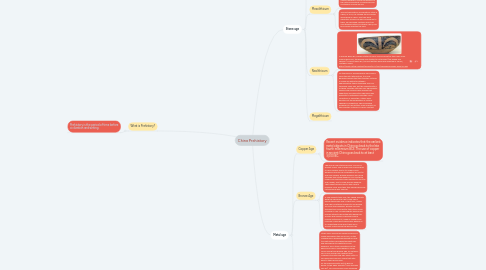
1. Stone age
1.1. Paleoliticum
1.1.1. The mankind of the Paleolithic Age is represented by 'Hetao Man' who lived about 500,000 to 350,000 years ago. The fossils of which were dug up in North China's Inner Mongolia, 'Liujiang Man', whose fossils were discovered in Liuzhou, two hours away from Guilin, in South China's Guangxi Province, 'Zhiyu Man', and cavemen who lived about 300,000 years ago in caves.
1.1.2. The oldest tools are from stratum 6, which they dated to 35,000 years ago and consist of three sharp awls. The six probable spear points, awls, and a cutting tool found in stratum 5 were dated to 34,000 years ago. Two types of barbed points were found in stratum 3 and are believed to be between 23,000 and 18,000 years old.
1.2. Mesolithicum
1.2.1. The human started to envolved as a species and make a better stone tools. These early humans were nomadic Hunter-gatherers, relying completely of the natural availability of resources and continually moving around.
1.2.2. The first excavations of prehistoric sites in China, In 1947, Pei studied the microliths discovered in China. This they were Mesolithic remains as well be assigned to them, Pei remained cautious about his cave dwelling sites in southern China, has profoundly affected the field.
1.3. Neolithicum
1.3.1. In around 8000 BC, people started to farm rice and millet as their main food. Around 6000 BC, the people also started to eat animals (like sheep and chicken). In about 3500 BC, the first pottery bowl was invented in Henan, Northern China. https://quatr.us/wp-content/uploads/2017/06/china3500bcbowl-300x140.jpg
1.3.2. On the basis of archaeological discoveries since the late 19th century, it is now generally agreed that the Neolithic cultures in China are dated to between approximately twelve thousand and four thousand years ago, but the characteristics of these Neolithic cultures vary significantly. While some scholars have argued that sedentism and agriculture should be key elements to distinguish Neolithic from Mesolithic or Paleolithic, others have pointed out the uniqueness of cultural changes in prehistoric China and have proposed to use pottery as an indicator of the Neolithic cultures in China’s context.
1.4. Megalithicum
2. Metal age
2.1. Copper Age
2.1.1. Recent evidence indicates that the earliest metal objects in China go back to the late fourth millennium BCE. The use of copper in ancient China goes back to at least 3,000 BC.
2.2. Bronze Age
2.2.1. The Bronze Age started around 1700 BC in ancient China. This is when men learned how to mine copper and tin to make bronze weapons. Bronze is a combination of 10% tin and 90% copper. Bronze weapons are much stronger than stone weapons. For one thing, miners and craftsmen were needed to mine tin and copper, and to make bronze weapons. That meant farmers had to learn how to produce more food than they needed because not everyone was farming.
2.2.2. A new dynasty took over, the Shang Dynasty. Both the Shang and Chou ruled China during the Bronze Age. In that time, Shang and Chou craftsmen learned to use bronze for more than weapons. Bronze survives through time much better than items made of wood or clay. Archaeologists have found bronze artifacts decorated with designs of animals and designs of people playing musical instruments, made in Shang times long ago. These discoveries have helped us to understand more about daily life in ancient China during the Bronze Age.
2.3. Iron Age
2.3.1. Other alloys like bronze became popular in China long before the use of iron, so the Chinese had a working knowledge of how to smelt metals using high temperatures and hammering to create tools and weapons. As in other civilizations of the period iron use in China began in crude forms during their Bronze Age, as meteoric iron or iron found from meteors that crashed into Earth long ago. Early casts of iron have been found in China that date back to their Bronze Age. As the Shang Dynasty lost its grip on power to the Zhou Dynasty (1046 through 256 BC), iron use became more advanced.
2.3.2. The Zhou came into power by way of force, and after establishing their dominance brought China into a period of advanced technology that included using more iron to create better and stronger weapons. These years were the beginning of the Iron Age in China, which officially began around 600 CE. The Zhou Dynasty was able to hold absolute power until 776 BC when the Warring States Period began in China. The lord who had the best weapons had the best chance at ruling. A new form of iron replaced meteoric iron during the Chinese Iron Age called pig iron, which was easier to work with and malleable. One of their early attempts to increase iron production was to appoint bureaucrats to oversee areas of China where iron was predominant. As the rule of the Qin was short-lived, further innovations made during the Iron Age were made under later dynasties.

